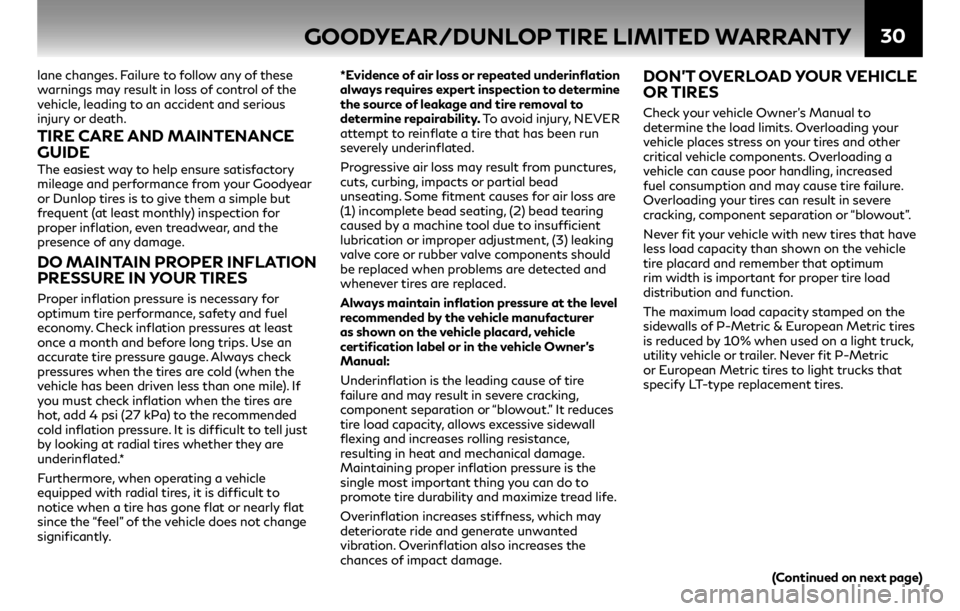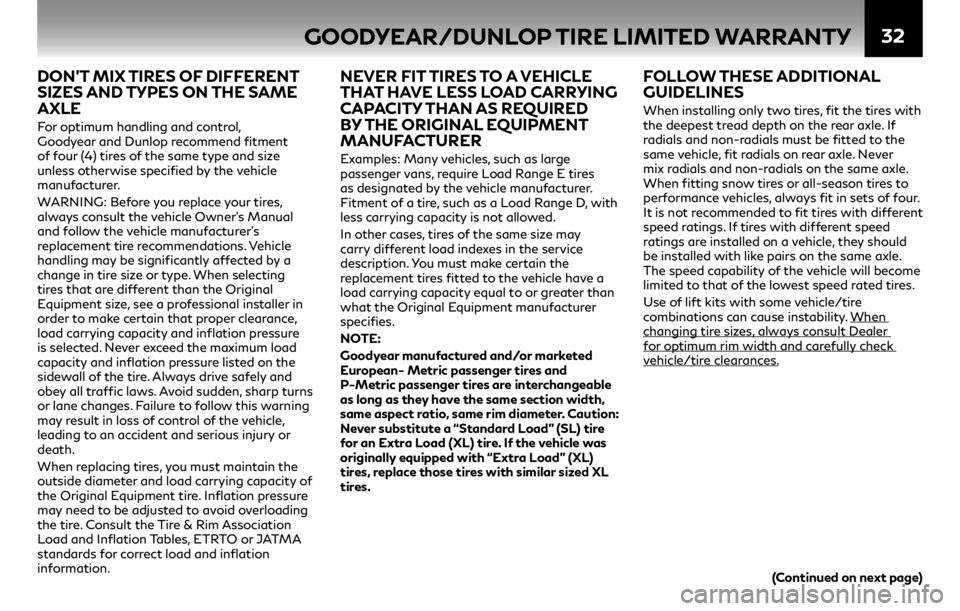width INFINITI QX30 2018 Warranty Information Booklet
[x] Cancel search | Manufacturer: INFINITI, Model Year: 2018, Model line: QX30, Model: INFINITI QX30 2018Pages: 60, PDF Size: 0.24 MB
Page 33 of 60

30
lane changes. Failure to follow any of these
warnings may result in loss of control of the
vehicle, leading to an accident and serious
injury or death.
TIRE CARE AND MAINTENANCE
GUIDE
The easiest way to help ensure satisfactory
mileage and performance from your Goodyear
or Dunlop tires is to give them a simple but
frequent (at least monthly) inspection for
proper inflation, even treadwear, and the
presence of any damage.
DO MAINTAIN PROPER INFLATION
PRESSURE IN YOUR TIRES
Proper inflation pressure is necessary for
optimum tire performance, safety and fuel
economy. Check inflation pressures at least
once a month and before long trips. Use an
accurate tire pressure gauge. Always check
pressures when the tires are cold (when the
vehicle has been driven less than one mile). If
you must check inflation when the tires are
hot, add 4 psi (27 kPa) to the recommended
cold inflation pressure. It is difficult to tell just
by looking at radial tires whether they are
underinflated.*
Furthermore, when operating a vehicle
equipped with radial tires, it is difficult to
notice when a tire has gone flat or nearly flat
since the “feel” of the vehicle does not change
significantly.*Evidence of air loss or repeated underinflation
always requires expert inspection to determine
the source of leakage and tire removal to
determine repairability. To avoid injury, NEVER
attempt to reinflate a tire that has been run
severely underinflated.
Progressive air loss may result from punctures,
cuts, curbing, impacts or partial bead
unseating. Some fitment causes for air loss are
(1) incomplete bead seating, (2) bead tearing
caused by a machine tool due to insufficient
lubrication or improper adjustment, (3) leaking
valve core or rubber valve components should
be replaced when problems are detected and
whenever tires are replaced.
Always maintain inflation pressure at the level
recommended by the vehicle manufacturer
as shown on the vehicle placard, vehicle
certification label or in the vehicle Owner’s
Manual:
Underinflation is the leading cause of tire
failure and may result in severe cracking,
component separation or “blowout.” It reduces
tire load capacity, allows excessive sidewall
flexing and increases rolling resistance,
resulting in heat and mechanical damage.
Maintaining proper inflation pressure is the
single most important thing you can do to
promote tire durability and maximize tread life.
Overinflation increases stiffness, which may
deteriorate ride and generate unwanted
vibration. Overinflation also increases the
chances of impact damage.
DON’T OVERLOAD YOUR VEHICLE
OR TIRES
Check your vehicle Owner’s Manual to
determine the load limits. Overloading your
vehicle places stress on your tires and other
critical vehicle components. Overloading a
vehicle can cause poor handling, increased
fuel consumption and may cause tire failure.
Overloading your tires can result in severe
cracking, component separation or “blowout”.
Never fit your vehicle with new tires that have
less load capacity than shown on the vehicle
tire placard and remember that optimum
rim width is important for proper tire load
distribution and function.
The maximum load capacity stamped on the
sidewalls of P-Metric & European Metric tires
is reduced by 10% when used on a light truck,
utility vehicle or trailer. Never fit P-Metric
or European Metric tires to light trucks that
specify LT-type replacement tires.
(Continued on next page)
GOODYEAR/DUNLOP TIRE LIMITED WARRANTY
Page 35 of 60

32
DON’T MIX TIRES OF DIFFERENT
SIZES AND TYPES ON THE SAME
AXLE
For optimum handling and control,
Goodyear and Dunlop recommend fitment
of four (4) tires of the same type and size
unless otherwise specified by the vehicle
manufacturer.
WARNING: Before you replace your tires,
always consult the vehicle Owner’s Manual
and follow the vehicle manufacturer’s
replacement tire recommendations. Vehicle
handling may be significantly affected by a
change in tire size or type. When selecting
tires that are different than the Original
Equipment size, see a professional installer in
order to make certain that proper clearance,
load carrying capacity and inflation pressure
is selected. Never exceed the maximum load
capacity and inflation pressure listed on the
sidewall of the tire. Always drive safely and
obey all traffic laws. Avoid sudden, sharp turns
or lane changes. Failure to follow this warning
may result in loss of control of the vehicle,
leading to an accident and serious injury or
death.
When replacing tires, you must maintain the
outside diameter and load carrying capacity of
the Original Equipment tire. Inflation pressure
may need to be adjusted to avoid overloading
the tire. Consult the Tire & Rim Association
Load and Inflation Tables, ETRTO or JATMA
standards for correct load and inflation
information.
NEVER FIT TIRES TO A VEHICLE
THAT HAVE LESS LOAD CARRYING
CAPACITY THAN AS REQUIRED
BY THE ORIGINAL EQUIPMENT
MANUFACTURER
Examples: Many vehicles, such as large
passenger vans, require Load Range E tires
as designated by the vehicle manufacturer.
Fitment of a tire, such as a Load Range D, with
less carrying capacity is not allowed.
In other cases, tires of the same size may
carry different load indexes in the service
description. You must make certain the
replacement tires fitted to the vehicle have a
load carrying capacity equal to or greater than
what the Original Equipment manufacturer
specifies.
NOTE:
Goodyear manufactured and/or marketed
European- Metric passenger tires and
P-Metric passenger tires are interchangeable
as long as they have the same section width,
same aspect ratio, same rim diameter. Caution:
Never substitute a “Standard Load” (SL) tire
for an Extra Load (XL) tire. If the vehicle was
originally equipped with “Extra Load” (XL)
tires, replace those tires with similar sized XL
tires.
FOLLOW THESE ADDITIONAL
GUIDELINES
When installing only two tires, fit the tires with
the deepest tread depth on the rear axle. If
radials and non-radials must be fitted to the
same vehicle, fit radials on rear axle. Never
mix radials and non-radials on the same axle.
When fitting snow tires or all-season tires to
performance vehicles, always fit in sets of four.
It is not recommended to fit tires with different
speed ratings. If tires with different speed
ratings are installed on a vehicle, they should
be installed with like pairs on the same axle.
The speed capability of the vehicle will become
limited to that of the lowest speed rated tires.
Use of lift kits with some vehicle/tire
combinations can cause instability. When
changing tire sizes, always consult Dealer
for optimum rim width and carefully check
vehicle/tire clearances.
GOODYEAR/DUNLOP TIRE LIMITED WARRANTY
(Continued on next page)